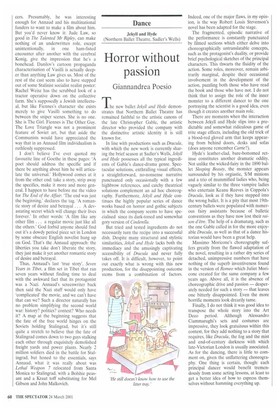Dance
Jekyll and Hyde (Northern Ballet Theatre, Sadler's Wells)
Horror without passion
Giannandrea Poesio
The new ballet Jekyll and Hyde demonstrates that Northern Ballet Theatre has remained faithful to the artistic canons of the late Christopher Gable, the artistic director who provided the company with the distinctive artistic identity it is still known for.
In line with productions such as Dracula, with which the new work is currently sharing the brief season at Sadler's Wells, Jekyll and Hyde possesses all the typical ingredients of Gable's dance-drama genre. Spectacular solutions, enthralling visual effects, a straightforward, no-nonsense narrative punctuated only occasionally with a few highbrow references, and catchy theatrical solutions complement an ad hoc choreography. Furthermore. Jekyll and Hyde continues the highly popular series of dance works based on horror and gothic subjects in which the company seems to have specialised since its dark-toned and somewhat gory version of Cinderella.
But tried and tested ingredients do not necessarily turn the recipe into a successful dish. Despite many structural and stylistic similarities, Jekyll and Hyde lacks both the immediacy and the amusingly captivating accessibility of Dracula and never fully takes off. It is difficult, however, to point out exactly what is wrong with this new production, for the disappointing outcome stems from a combination of factors. Indeed, one of the major flaws, in my opinion, is the way Robert Louis Stevenson's novel has been adapted for the stage.
The fragmented, episodic narrative of the performance is constantly punctuated by filmed sections which either delve into choreographically untranslatable concepts, such as the protagonist's duality, or provide brief psychological sketches of the principal characters. This thwarts the fluidity of the action. Some roles, moreover, remain arbitrarily marginal, despite their occasional involvement in the development of the action, puzzling both those who have read the book and those who have not. I do not think that to assign the role of the inner monster to a different dancer to the one portraying the scientist is a good idea, even though it creates another main role.
There are moments when the interaction between Jekyll and Hyde slips into a predictable and somewhat ridiculous game of trite stage effects, including the old trick of a blood-red gloved arm that keeps appearing from behind doors, desks and sofas (does anyone remember Carrie?).
Hyde's leather-clad, bare-bottomed retinue constitutes another dramatic oddity. Not unlike the wicked-fairy in the 1890 ballet Sleeping Beauty, the monster appears surrounded by his orgiastic, S/M minions and a trio of mummified ladies who, being vaguely similar to the three vampire ladies who entertain Keanu Reeves in Coppola's Dracula, look as if they have stepped into the wrong ballet. It is a pity that most 19thcentury ballets were populated with numerous fairy assistants because of balletic conventions as they have now lost their raison d'être. The help of a dramaturg, such as the one Gable called in for the more enjoyable Dracula, as well as that of a dance historian would have been a great help.
Massimo Moricone's choreography suffers greatly from the flawed adaptation of the novel, resulting in a rather dry series of detached, unimpressive numbers that have nothing of the superb inventiveness found in the version of Romeo which Juliet Moricone created for the same company a few years ago. Above all, it is the absence of choreographic drive and passion — desperately needed for such a story — that leaves one bitterly disappointed. Even the more horrific moments look drearily tame.
Finally, I do not think it was good idea to transpose the whole story into the Art Deco period. Although Alessandro Ciammarughi's sets and costumes are impressive, they look gratuitous within this context, for they add nothing to a story that requires, like Dracula, the fog and the mist and end-of-century darkness with which late-Victorian London is usually associated. As for the dancing, there is little to comment on, given the unflattering choreography. One thing is certain, though: each principal dancer would benefit tremendously from some acting lessons, at least to get a better idea of how to express themselves without hamming everything up.














































































 Previous page
Previous page